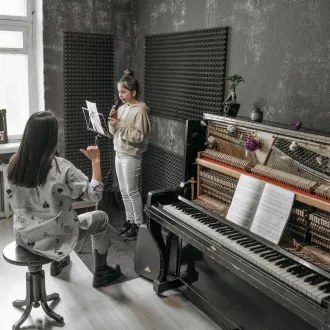Transcription Exercises for proper articulation
Proper articulation is essential for clear and effective communication. Good articulation allows us to pronounce sounds accurately, facilitating comprehension and avoiding misunderstandings in our verbal interactions. In this session, we will explore a series of exercises designed to improve articulation and achieve more accurate and distinctive pronunciation. These exercises are essential for those who wish to perfect their communication skills and develop a clear and convincing voice.
Individual Sound Pronunciation Exercise: This exercise focuses on practicing the individual sounds of the language. Start by identifying those sounds that you find most difficult to pronounce and concentrate on them. Repeat each sound aloud several times, paying attention to the position of your mouth, tongue and lips. For example, if you have difficulty with the pronunciation of the vibrant "r", practice pronouncing it in isolation until you feel comfortable and can produce the sound clearly and distinctly.
Vocalization exercise: Proper vocalization is key to clear articulation. This exercise consists of performing a series of vocalizations, starting from the most open and extended sounds to the most closed and high-pitched. For example, you can start with long, open vowels, such as "a" and "o", and then progress to the more closed vowels, such as "i" and "u". Be sure to pronounce each vowel clearly and emphasize its distinctive sound.
Rapid Articulation Word and Phrase Exercise: This exercise focuses on speed and accuracy of articulation. Choose words and phrases that contain challenging sound combinations and practice pronouncing them quickly without losing clarity. You can use tongue twisters or create your own word combinations. The key here is to make sure that each sound is pronounced clearly and distinctly, even at high speed.
Read aloud exercise: Reading aloud is an excellent way to improve articulation. Choose texts that contain a variety of sounds and word structures and practice reading them aloud. Pay attention to the pronunciation of each word, making sure to clearly articulate each sound. Try to read with fluency and rhythm, avoiding stumbles and hesitations.
Chewing and jaw mobility exercise: Jaw mobility also plays an important role in proper articulation. Perform chewing exercises and circular movements with the jaw to keep it relaxed and flexible. This will help prevent tension in the facial muscles and allow for more accurate articulation of sounds.
Facial resonance exercise: Facial resonance plays an important role in clarity of articulation. This exercise focuses on strengthening the facial muscles and improving voice resonance. Start by performing facial movements such as broad smiles, grimaces and surprised gestures. Accompany these movements with the pronunciation of sounds or words, paying attention to how the voice is amplified and projected through the nasal cavity and sinuses. This will help improve resonance and clarity in articulation.
Diction exercise with difficult letters: Some letters may present specific articulation challenges. Identify the letters that are most difficult for you to pronounce and practice articulating them in isolation. For example, if you have difficulty with the soft "s", practice pronouncing it in different mouth positions and in combination with different vowels. Work on improving the clarity and sharpness of each sound.
joint exercises




